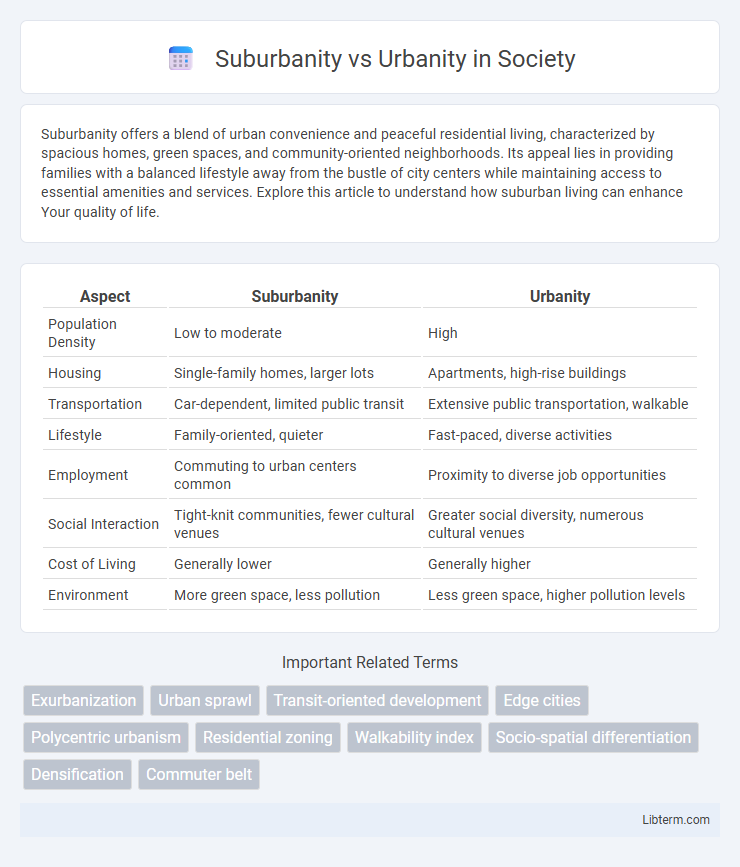Suburbanity offers a blend of urban convenience and peaceful residential living, characterized by spacious homes, green spaces, and community-oriented neighborhoods. Its appeal lies in providing families with a balanced lifestyle away from the bustle of city centers while maintaining access to essential amenities and services. Explore this article to understand how suburban living can enhance Your quality of life.
Table of Comparison
| Aspect | Suburbanity | Urbanity |
|---|---|---|
| Population Density | Low to moderate | High |
| Housing | Single-family homes, larger lots | Apartments, high-rise buildings |
| Transportation | Car-dependent, limited public transit | Extensive public transportation, walkable |
| Lifestyle | Family-oriented, quieter | Fast-paced, diverse activities |
| Employment | Commuting to urban centers common | Proximity to diverse job opportunities |
| Social Interaction | Tight-knit communities, fewer cultural venues | Greater social diversity, numerous cultural venues |
| Cost of Living | Generally lower | Generally higher |
| Environment | More green space, less pollution | Less green space, higher pollution levels |
Defining Suburbanity and Urbanity
Suburbanity refers to the characteristics and lifestyle associated with residential areas located on the outskirts of a city, marked by lower population density, single-family homes, and reliance on automobiles. Urbanity denotes the qualities of city life, featuring higher population density, mixed-use developments, public transit accessibility, and diverse social and economic activities. Defining these concepts involves examining spatial organization, demographic patterns, and infrastructure that differentiate suburban environments from urban centers.
Historical Development of Urban and Suburban Areas
The historical development of urban areas traces back to ancient civilizations where centralized trade, governance, and social structures fostered dense populations and complex infrastructures. Suburbanity emerged notably in the 19th and 20th centuries, driven by industrialization, transportation advancements, and the desire for residential space outside crowded city centers. The expansion of railroads, highways, and automobiles facilitated suburban growth, leading to distinct patterns of land use and socio-economic separation from urban cores.
Population Density and Spatial Organization
Population density in suburban areas typically ranges from 1,000 to 3,000 people per square mile, contrasting sharply with urban centers where densities often exceed 10,000 people per square mile. Spatial organization in suburbs emphasizes lower building heights, detached housing, and expansive green spaces, while urban areas feature high-rise buildings, mixed-use developments, and tightly packed infrastructure. These differences impact transportation patterns, land use efficiency, and community interactions across the suburban-urban spectrum.
Lifestyle and Community Dynamics
Suburbanity often emphasizes spacious living environments, family-oriented lifestyles, and a stronger sense of local community engagement, characterized by neighborhood associations and communal events. Urbanity promotes a fast-paced lifestyle with diverse cultural interactions, high-density housing, and access to extensive public transportation systems, fostering dynamic social networks and economic opportunities. Community dynamics in suburbs tend to center around stability and homogeneity, while urban areas thrive on multiculturalism and continuous social exchange.
Transportation and Commuting Patterns
Suburbanity often features reliance on private vehicles due to limited public transit options, leading to longer commute times and higher traffic congestion. Urbanity typically benefits from dense, multimodal transportation networks including buses, subways, and bike lanes, promoting shorter, more efficient commutes. These contrasting commuting patterns influence environmental impacts, with urban areas generally producing lower per capita carbon emissions from transportation compared to sprawling suburban regions.
Access to Amenities and Services
Suburban areas typically offer easier access to large retail centers, parks, and schools, often requiring car travel, while urban areas provide a dense concentration of amenities such as public transportation, healthcare facilities, and cultural institutions within walking distance. The availability of diverse services like restaurants, entertainment, and professional offices is generally higher in urban environments, facilitating convenience and reducing commute times. Suburban residents may experience fewer options for public transit and entertainment but benefit from larger spaces and quieter neighborhoods.
Environmental Impact and Sustainability
Suburbanity typically involves lower population density and greater reliance on private vehicles, leading to increased greenhouse gas emissions and habitat fragmentation compared to urbanity. Urban environments promote higher walkability, public transit use, and energy-efficient infrastructure, contributing to reduced carbon footprints and enhanced sustainability. Sustainable urban planning emphasizes green spaces, mixed-use developments, and renewable energy integration to mitigate environmental impacts associated with dense human habitation.
Cultural Diversity and Social Connections
Suburbanity often features less cultural diversity compared to urbanity, where a broad mix of ethnicities, languages, and traditions thrive in densely populated areas. Urban environments foster stronger social connections through public spaces, cultural institutions, and diverse community events, enhancing intercultural interaction. In contrast, suburban areas typically experience more homogeneous populations and social networks centered around localized, family-oriented activities.
Economic Opportunities and Challenges
Suburban areas offer expanding economic opportunities driven by lower operational costs, affordable housing, and growing sectors such as logistics and retail. Urban centers present concentrated access to diverse industries, innovation hubs, and high-skilled employment but face challenges like high living expenses and infrastructure strain. Economic growth in suburbs can alleviate urban congestion while urbanity fosters dynamic job markets crucial for specialized professions.
Future Trends in Urban and Suburban Living
Future trends in urban and suburban living emphasize increased integration of smart technologies, sustainable infrastructure, and mixed-use developments to enhance connectivity and quality of life. Suburban areas are adopting urban characteristics such as walkability and public transit options, while cities are expanding green spaces and affordable housing to counter urban density challenges. Demographic shifts and remote work advancements continue to reshape the balance between suburban comfort and urban accessibility.
Suburbanity Infographic

 libterm.com
libterm.com